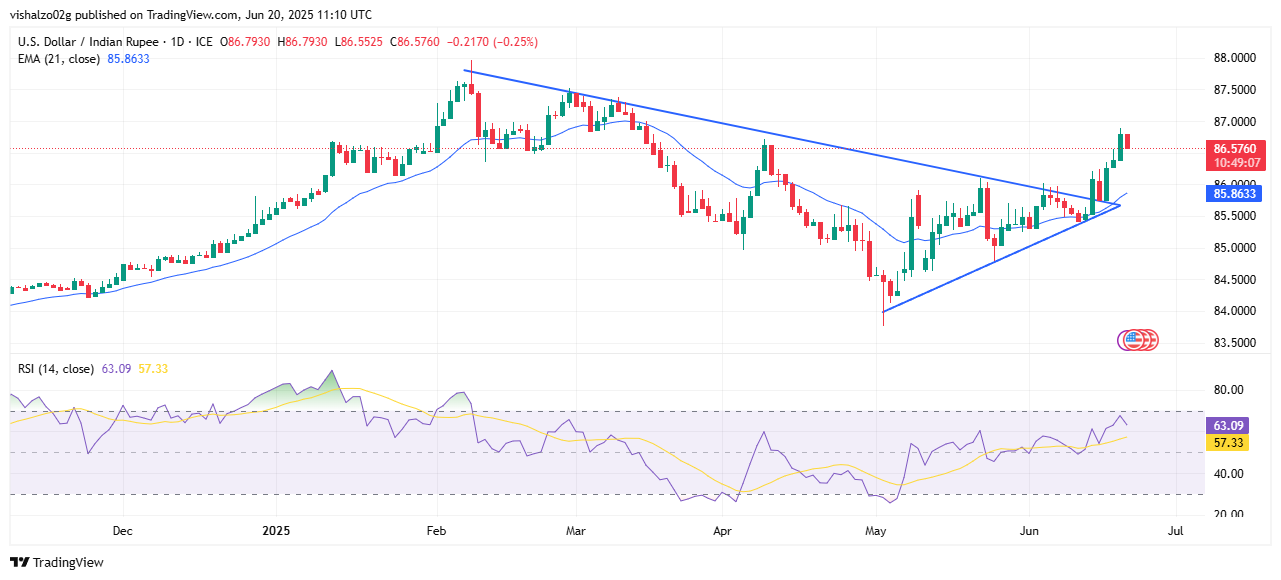Indian Rupee edges higher as Oil retreats, Equities jump, USD/INR holds ground
- INR recovers slightly on Friday, lifted by gains in domestic Stocks and a softer US Dollar.
- Brent Crude Oil trims recent gains but holds a weekly rise of over 4% so far as Middle East tensions persist.
- Equity benchmarks Sensex and Nifty rally over 1% each, snapping a three-day losing streak.
- RBI minutes showed CPI forecast cut to 3.7% for FY26; retail inflation hit a 75-month low at 2.82% in May.
The Indian Rupee (INR) snaps its three-day losing run against the US Dollar (USD) on Friday, recovering modestly after hitting a three-month low the previous day. A softer Greenback and a pullback in Crude Oil prices lent support to the Rupee, as traders digest US President Donald Trump's two-week delay to decide if the US will step into the Israel–Iran air conflict.
USD/INR is drifting lower during the American trading hours, last seen trading around 86.60 at the time of writing. The pair has eased from its multi-month high but remains up over 0.50% for the week, underpinned by elevated Crude Oil prices amid the ongoing Iran–Israel conflict.
While Trump’s two-week window to decide about Iran has temporarily calmed fears of an immediate escalation, risk appetite stays fragile as the conflict entered its eighth day on Friday with continued missile strikes and no clear path to de-escalation. Investors remain cautious that any miscalculation could disrupt energy flows and weigh further on emerging market currencies like the Rupee, particularly if Crude Oil prices reverse course and climb higher again.
Market Movers: Oil, Equities, Geopolitics shape Rupee moves
- The Indian Rupee edged higher on Friday, aided by strength in domestic equity markets, which helped lift sentiment. A relatively steady trend in global Crude Oil prices also provided some relief to the energy-import-reliant currency.
- Fresh domestic data is reinforcing India’s growth outlook. A new report from Motilal Oswal Private Wealth (MOPW) on Friday noted that the economy is benefiting from multiple supportive trends: GDP growth accelerated to 7.4% in Q4 FY25 — the strongest in a year — while inflation has stayed below 4% for four straight months, and GST revenues continue to rise steadily. These factors point to robust demand and stable formal-sector activity, helping underpin market sentiment for the Rupee.
- India’s core sector growth slowed sharply to 0.7% in May, down from 6.9% in the same month last year, according to official data released on June 20. The Index of Core Industries, which tracks output in eight major industries including coal, crude oil, steel, and electricity, accounts for over 40% of the country’s total industrial production. The weaker print highlights patchy momentum in heavy industry despite stronger headline GDP growth.
- India’s benchmark equity indices bounced back sharply on Friday after three days of losses, boosting overall market sentiment. The 30-share BSE Sensex jumped 1,046.30 points, or 1.29%, to close at 82,408.17, while the NSE Nifty50 rose 319.15 points, or 1.29%, to finish at 25,112.40.
- Brent Crude has slipped over 2% so far on Friday, easing near $77 per barrel as traders reacted to signs that the US may hold off immediate military action in the Israel–Iran conflict. Despite the dip, prices are still set for a weekly gain near 4%, keeping energy markets sensitive to any fresh escalation that could disrupt supply routes.
- The Reserve Bank of India (RBI) released the minutes from its June 4–6 Monetary Policy Committee meeting on Friday. The June meeting saw the RBI cut the repo rate by 50 bps to 5.5 percent, marking the second back-to-back cut since February.
- RBI Governor Sanjay Malhotra said that the central bank’s cumulative 100 basis points cut in the repo rate and a matching 100 bps reduction in the Cash Reserve Ratio (CRR) since February will help anchor stability amid global volatility and support India’s growth momentum in the near term. “This package of measures will provide some certainty in the times of uncertainty and is expected to support growth,” highlighting that the combined 100 bps cuts in both the repo rate and CRR since February aim to bolster India’s resilience amid global market swings.
- India’s central bank lowered its CPI inflation forecast to 3.7% for FY26, down from an earlier estimate of 4%. Supporting this, retail inflation dropped to a 75-month low of 2.82% in May, easing from 3.2% in April, as food inflation fell below 1% for the first time in almost four years. The sharp disinflation trend has strengthened the case for an accommodative policy stance, supporting the sentiment for the Rupee.
- Investor nerves remain heightened as the Iran–Israel war entered its eighth day, officials on all sides continue to trade sharp warnings. US President Trump reiterated on Thursday that he would “make a decision in the next two weeks” but stressed he still believes “there is room for diplomacy” with Tehran. Israel’s Prime Minister Benjamin Netanyahu declared that his country “will act alone if necessary,” signalling readiness to strike Iran’s Fordow nuclear site without US assistance. Meanwhile, a senior Iranian lawmaker warned that closing the Strait of Hormuz is “a real option” if Washington escalates, calling US military involvement a clear “red line” for Tehran.
- The US Dollar Index (DXY), which measures the Greenback’s value against a basket of six major currencies, edges lower on Friday, slipping back below the 99.00 mark. The index has eased from its weekly high touched on Thursday, and was last seen trading near 98.75 as traders reassess safe-haven demand.
- The Philadelphia Fed Manufacturing Index held steady at -4.0 in June 2025, unchanged from May and missing market expectations of a milder decline to -1. The reading highlights that manufacturing activity in the region remains sluggish, hindered by softening demand and cooling labor market conditions. Firms surveyed reported weaker new orders and a modest drop in employment, adding to evidence that the sector is losing momentum amid elevated borrowing costs and lingering economic uncertainty. Earlier this week, the central bank kept its benchmark rate unchanged at 4.25%–4.50% during its July meeting, as officials weigh sticky inflation against signs of slowing growth.
- Looking ahead, traders will watch fresh Purchasing Managers’ Index (PMI) data due Monday for both India and the US.
Technical Analysis: Bulls pause after multi-month high, key support at 86.00 in focus

USD/INR is showing early signs of a potential pause after a decisive breakout from a multi-month symmetrical triangle. Friday’s price action is forming a bearish daily candle, highlighting that the pair is struggling to hold gains after testing the psychological 87.00 barrier.
The breakout above the triangle resistance and the 21-day Exponential Moving Average (EMA), which now sits around 85.86, confirmed a shift in near-term sentiment from neutral to bullish earlier this week. However, the pair’s failure to close firmly above 87.00 has attracted profit-taking, raising the risk of a short-term pullback.
The Relative Strength Index (RSI) has cooled slightly from near overbought territory but remains comfortably above the neutral 50 level, suggesting that buyers still have control as long as the pair stays above the former triangle resistance, now acting as a support zone around 85.80–86.00.
Economic Indicator
HSBC Composite PMI
The Composite Purchasing Managers Index (PMI), released on a monthly basis by S&P Global and HSBC Bank, is a leading indicator gauging business activity in India This d by weighting together comparable manufacturing and services indices using official manufacturing and services annual value added. The index varies between 0 and 100, with levels of 50.0 signaling no change over the previous month. A reading above 50 indicates that the Indian private economy is generally expanding, a bullish sign for the Indian Rupee (INR). Meanwhile, a reading below 50 signals that the activity is generally declining, which is seen as bearish for INR.
Read more.Next release: Mon Jun 23, 2025 05:00 (Prel)
Frequency: Monthly
Consensus: -
Previous: 59.3
Source: S&P Global



